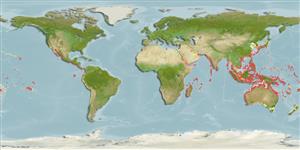Malacostraca |
Decapoda |
Palaemonidae
Environment: milieu / climate zone / depth range / distribution range
Ecology
Reef-associated; depth range 6 - 30 m (Ref. 83472). Tropical
Indo-Pacific.
Length at first maturity / Size / Weight / Age
Maturity: Lm ? range ? - ? cm
Body is almost transparent, with small brown or purple spots present at the posterior carapace and sometimes the abdomen. Body has a distinct V-shaped white and yellow patch on the third abdominal tergum. Legs and tail are white, with blue or purple near the joints and tips. Rostrum is usually arched and toothed.
In shallow waters, to depths reaching 30 meters. Mainly associated with sea anemones, but also observed on hard corals and jellyfish (Ref. 125532).
Life cycle and mating behavior
Maturity | Reproduction | Spawning | Eggs | Fecundity | Larvae
Members of the order Decapoda are mostly gonochoric. Mating behavior: Precopulatory courtship ritual is common (through olfactory and tactile cues); usually indirect sperm transfer.
Li, X. and J.Y. Liu 2004 Report of Pontoniinae shrimps (Crustacea: Decapoda) collected by joint Chinese-German Marine Biology Expeditions to Hainan Island, South China Sea. III. Periclimenes. Chinese Journal of Oceanology and Limnology 22(1):89-100. (Ref. 81533)
IUCN Red List Status
(Ref. 130435: Version 2025-1)
CITES status (Ref. 108899)
Not Evaluated
Not Evaluated
Threat to humans
Human uses
| FishSource |
Tools
More information
Trophic EcologyFood items (preys)
Diet composition
Food consumption
Predators
Population dynamicsGrowth
Max. ages / sizes
Length-weight rel.
Length-length rel.
Length-frequencies
Mass conversion
Abundance
Life cycleReproductionMaturityFecunditySpawningEggsEgg developmentLarvae PhysiologyOxygen consumption
Human RelatedStamps, coins, misc.
Internet sources
Estimates based on models
Preferred temperature
(Ref.
115969): 21.4 - 29.2, mean 28.3 (based on 3670 cells).
